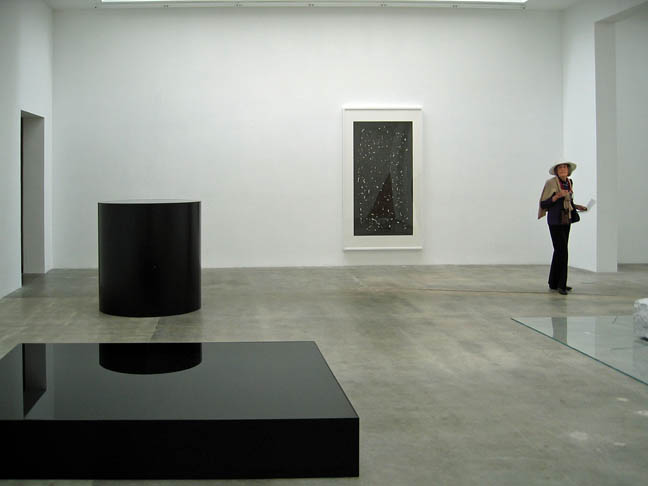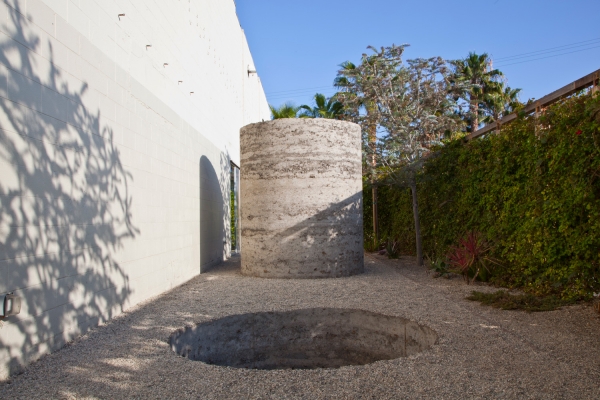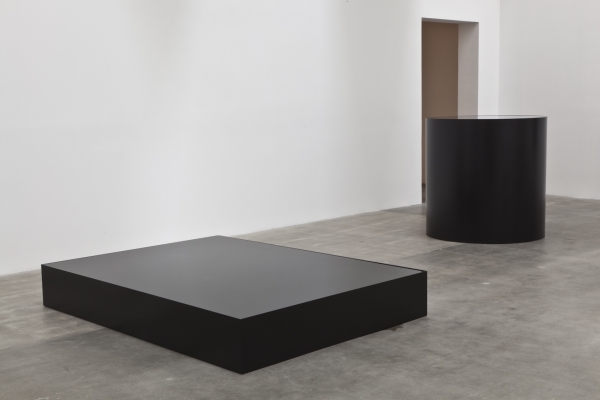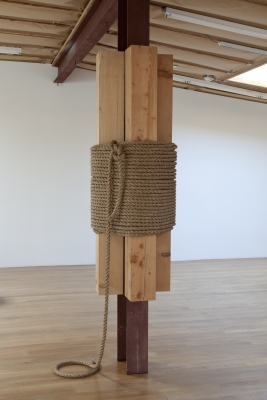
Barbara at the Blum and Poe exhiition, Photo by Eva Scherwitz
Three Sculptors from the Exhibition
”Requiem for the Sun: The Art of Mono-Ha”
A retrospective at the Blum and Poe Gallery in Los
Angeles
February 25 – April 14, 2012
Curated by Mika
Yoshitake

Barbara
at the Blum and Poe exhiition, Photo by Eva Scherwitz
From the Announcement of the Gallery
Blum & Poe Gallery in Los Angeles is pleased to announce its
forthcoming exhibition “Requiem for the Sun: The Art of Mono-Ha”
This exhibition examines the postwar Japanese artistic phenomenon
Mono-ha (School of Things), following the solo exhibition of
Mono-ha's key ideologue, Lee Ufan at the gallery in January 2010.
Representing an important art historical turning point, "Requiem
for the Sun" refers to the attitude of aesthetic detachment and
renewal of matter in response to the immanent loss of the object as a
sun in Japanese postwar art practice. Included in the exhibition are
works by Koji Enokura (1942-1995), Noriyuki Haraguchi (1946- ),
Susumu Koshimizu (1944- ), Katsuhiko Narita (1944-1991), Nobuo Sekine
(1942- ), Kishio Suga (1944- ), Jiro Takamatsu (1936-1998), Noboru
Takayama (1944- ), Lee Ufan (1936- ), and Katsuro Yoshida
(1943-1999).
Mono-Ha's primary tenet explores the encounter between natural and industrial objects, such as glass, stones, steel plates, wood, cotton, light bulbs, leather, oil, wire and Japanese paper, in and of themselves arranged directly on the floor or in an outdoor field. Evident in their works is a tendency based not on the art historical recuperation of objects, but on maintaining an affective relationship between works and our surrounding environment. That is, the works operate as a process of perceiving a perpetually passing present that opens the materiality of the work beyond what is simply seen. These practices are linked to the cultural milieu of process and post-minimalist art apparent on an international level during the 1960s and 1970s. What distinguishes their work is the refined technique of repetition as a studied production of difference developed over time in each artist's practice.
The exhibition will show select key installations, works on paper,
and photographs that unveil resonant concepts and artistic methods
relative to the exhibition. Some themes include perceiving works as
actions or events, experiments in topology and spatial continuity,
visceral materiality, and the contingency of the body. While the art
of Mono-ha has been the subject of exhibitions in Asia and Europe, it
is virtually unknown in North America. “Requiem for the Sun: The
Art of Mono-ha” will provide the audience with a critical
introduction to this significant work.
Blum
& Poe Gallery
Nobuo Sekine (1942-)

Nobu
Sekine, Phase-Mother Earth, Tokyo 1968/recreated in LA 2012
The emergence of Mono-ha has its roots in the social, political and cultural factors of the 1960s, and to trace its origins in detail is a complicated matter. However, the moment that is most often viewed as Mono-ha’s starting point came in October 1968 with Sekine’s ‘creation’ of the work Phase – Mother Earth in Kobe’s Sumarikyu Park for the First Open Air Contemporary Sculpture Exhibition. The work consisted of a hole dug into the ground, 2.7 metres deep and 2.2 metres in diameter, with the excavated earth compacted into a cylinder of exactly the same dimensions. Sekine described the moment when they removed the mould.
Nobu Sekine's “Phase” Objects 1968-1971
Topology was a key concept in Sekine’s work of the time; it gave a
severe jolt to the foundations which supported ideas of
three-dimensionality in art. Topological shapes are not regarded as
quantifiable entities, but rather seen as ‘phases’ extendable
over contraction and expansion. Sekine’s works since the ‘Phase’
series have also been influenced by Eastern philosophy, in particular
Zen, producing an unusual fusion of Western mathematics and ancient
Eastern aesthetics and philosophy.
Ashley
Rawlings/Tokyo Art Beat
|
|
|
|

Nobuo
Sekine
Phase of Nothingness-Water, 1969/2005
Steel, lacquer,
the objects are filled with water
Lee Ufan (1936-)
In November 1968 Sekine met the Korean-born artist Lee Ufan (b. 1936), who was soon to be of central importance to Mono-ha and the articulation of its ideas. Lee had studied ‘Asian thought’, including the philosophy of Laozi and Zhuangzi and after moving to Japan in 1956, had studied modern Western philosophy at Nihon University. Lee recognised the progressiveness of Sekine’s ideas and admired his work, whilst Sekine found in Lee a theoretician to support his artistic practice and views of art. Ashley Rawlings/Tokyo Art Beat
|
|
|

Lee Ufan |
Kishio Suga (1944 - )
Like Lee, Kishio Suga made works that were not exploring their material qualities as their ‘situation’. His work almost never juxtaposed differing materials in the same way as other Mono-ha artists did. Instead, one can say that through relationships and arrangements he studied how things exist. Ashley Rawlings/Tokyo Art Beat
|
|
|
Kishio Suga |
Susumu Koshimizu (1944-)
Conceptually, the work of Susumu Koshimizu bears resemblance to both
Lee and Suga’s. Like Suga he focuses on the qualities inherent to,
but not visible in an object. And yet, like Lee, he shows concern for
the materiality of objects; a desire to expose the fundamentals of
sculpture, often revealed through juxtaposition. In his work Paper 2
(later renamed Paper) (1969), he placed a large stone inside an even
larger envelope of Japanese paper, open on one side. The viewer is
able to look into the envelope and, in the sculptural context of
relating interior structure to exterior form, is confronted with the
sheer size and solidity of the stone in contrast to the thin membrane
of paper that covers and conceals it.
Ashley
Rawlings/Tokyo Art Beat
|
|
|
Susumu
Koshimizu |
The gallery also showed a selection of work by the following Mono-Ha artists among others:
|
|
|
|
All Photographs: Blum
& Poe Gallery 2012
Commentaries by Ashley
Rawlings